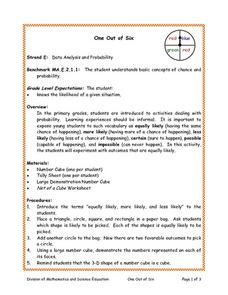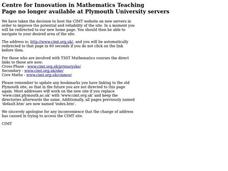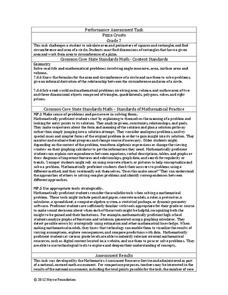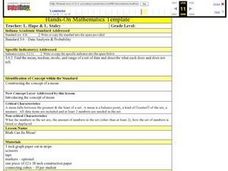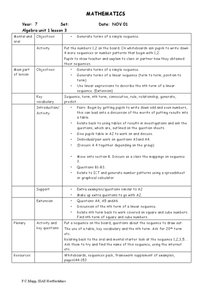Curated OER
Solving Square Root and Other Radical Equations
In this Algebra II worksheet, 11th graders solve equations involving radical equations. The worksheet provides an explanation and worked examples. The two page worksheet contains three problems. Solutions are not...
Del Mar College
Translating Verbal Expressions
Help scholars translate verbal expressions into numerical expressions. The two-page document is comprised of descriptions and examples that showcase terms and phrases related to addition, subtraction, multiplication, division,...
EngageNY
Analyzing a Graph
Collaborative groups utilize their knowledge of parent functions and transformations to determine the equations associated with graphs. The graph is then related to the scenario it represents.
EngageNY
Rational Exponents—What are 2^1/2 and 2^1/3?
Are you rooting for your high schoolers to learn about rational exponents? In the third installment of a 35-part module, pupils first learn the meaning of 2^(1/n) by estimating values on the graph of y = 2^x and by using algebraic...
Curated OER
How much room?
Students examine the amount of usable space that exists in their classroom using square meters and square centimeters. They apply the information to predict the ideal size of a classroom.
Curated OER
One Out of Six
Students investigate basic concepts of chance and probability. They make a number cube to predict which number might be rolled the most often out of 20 consecutive rolls and tally the results. Number cube template included.
Curated OER
My Shape Book
In these shapes worksheets, students identify, trace, and follow the directions to color numbers of plane and space figures. Students complete activities for twelve shapes and figures.
Curated OER
Index Notation
In this online index notation instructional activity, students fill in the missing powers in four statements, calculate nine math problems, fill in the missing bases and powers in six statements, calculate six higher power equations and...
Noyce Foundation
Pizza Crusts
Enough stuffed crust to go around. Pupils calculate the area and perimeter of a variety of pizza shapes, including rectangular and circular. Individuals design rectangular pizzas with a given area to maximize the amount of crust and do...
Curated OER
Color Me Square
Second graders identify and describe basic geometric solids. Working as a class, 2nd graders describe geometric solids using the proper vocabulary and counting faces, bases, corners, and edges. In pairs, students use a computer drawing...
Curated OER
Science Number Practice
In this ESL worksheet, students describe 16 numbers to their partner, some in scientific notation. Students listen to their partner's numbers and write them down.
Curated OER
Maximum and Minimum Points
In this maximum and minimum points instructional activity, students solve and complete 12 various types of problems. First, they find the area of the smallest triangle given the point of intersection. Then, students find the volume of a...
Curated OER
Surface Area
Seventh graders explore surface area. They study the difference between two and three-dimensional objects. The teacher leads a discussion about finding the surface area of different size cubes. In pairs, 7th graders use graph paper to...
Curated OER
Centimeter Slinkies
Third graders estimate and measure the length of a whole color-segmented, candy gummy worm. Then, as students bite off each segment, they estimate, measure and record findings in an activity log.
Curated OER
Celebrating 100
First graders listen to story "The Pentathlon," discuss importance of number zero, create 100 badge to wear, look for and circle 100 sight words in newspaper, create pictures made with 100 squares of paper, and use interactive writing to...
Curated OER
Spheres
Students work algebraic expressions with various types of powers to find the solutions. They Students also become familiar with problems that involve the square roots of numbers. The work should be completed with computational accuracy.
Curated OER
Math Can Be Mean!
Fifth graders are introduced to the topic of means. Calculating the mean, mode and median, they describe what each set of numbers tell and do not tell about the data. They use a line graph to practice finding the mean. They also use...
Curated OER
Fourths of Sets
Students create a set of cards that represent factors of four and use these cards to play a game in which they practice separating numbers into fourths. They first practice separating numbers into fourths with a projected computer...
Curated OER
Float My Boat
Fourth graders, in groups, experiment with density and the displacement of water by creating and designing their own boats and seeing which boat holds the most centimeter cubes without sinking..
Curated OER
Construct Figures to Find Specific Volume
Sixth graders use number cubes to explore volume of two-dimensional shapes. They roll a die and construct a shape using the numbers rolled as measurements of the sides. They estimate the volume of a given object, and then use the...
EngageNY
Exponents
Powered up! Here's a great resource on exponents. Scholars build on their previous understanding of exponents to include all positive real number bases. Distinguishing between an and a^n is a major goal in the fifth instructional...
Curated OER
Simple Sequence
Pupils identify the nth term in a sequence. In this algebra lesson, students generate sequences given the formula for each sequence. They find the formula given the sequence.
Curated OER
Proving Quadrilaterals
In this geometry instructional activity, 10th graders identify the missing angles using the polygons sum conjecture. They measure exterior and interior angles using their angle theorems. There are 63 problems.
Del Mar College
Exponential and Radical Rules
So many rules and so little time. Make it easy and provide all the exponent and radical rules in one place as an easy reference guide. All of the properties come with several examples to show how the rules apply to different problems.







